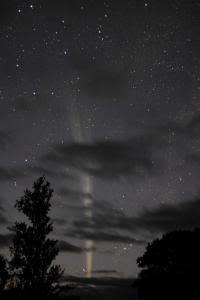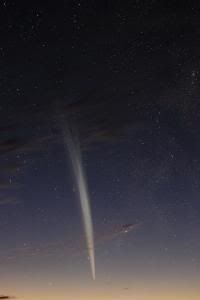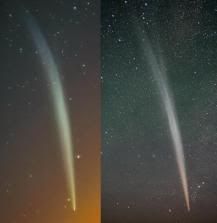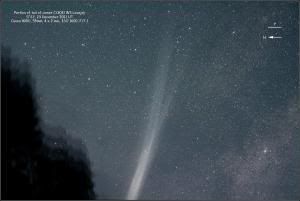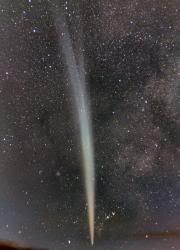Full Version: The Great Christmas Comet of 2011
Wow.
Very nice. Looks rather brighter than pieces of Milky Way in the image. With the help of Mongo's finder chart one can see Antares in the lower left corner, and Mu Scorpii to the upper right of the comet head.
On the spaceweather.com site there is a timelapse of the comet rising as seen from western Australia by Colin Legg. Worth looking at full screen:
http://vimeo.com/34007626
On the spaceweather.com site there is a timelapse of the comet rising as seen from western Australia by Colin Legg. Worth looking at full screen:
http://vimeo.com/34007626
There are some incredible movies now available from the Sungrazer website, which is linked to in the very first post in this thread.
First is this 7MB Quicktime movie from STEREO/SECCHI COR-1B. Very spectacular -- you first see the comet approaching the sun from the lower right, then the headless tail receding to the upper left, then the tail-less comet nucleus moving away from the sun toward the lower right as it begins to generate a new tail.
Second is this 30MB WMV movie from STEREO/SECCHI HI-1A, also a very striking movie of the comet departing from the sun..
First is this 7MB Quicktime movie from STEREO/SECCHI COR-1B. Very spectacular -- you first see the comet approaching the sun from the lower right, then the headless tail receding to the upper left, then the tail-less comet nucleus moving away from the sun toward the lower right as it begins to generate a new tail.
Second is this 30MB WMV movie from STEREO/SECCHI HI-1A, also a very striking movie of the comet departing from the sun..
The latest image of Comet Lovejoy, by Colin Legg. The comet is starting to move into darker skies.
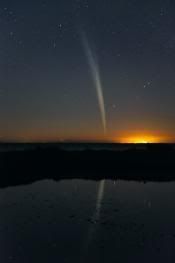
Here is the latest report from Dave Herald from comet-ml post #19013:

Here is the latest report from Dave Herald from comet-ml post #19013:
QUOTE
At long last the skies are clear in the Canberra region. The nucleus for Lovejoy doesn't rise for another half hour. But already the tail is visible to the naked eye, extending a full 10 deg above the horizon. The surface brightness is similar to the Magellanic clouds - even though they are higher in the sky.
Dave Herald
Murrumbateman, Australia
Dave Herald
Murrumbateman, Australia
Wow! 
This time lapse via a tip from Emily's Twitter:
http://www.nasa.gov/multimedia/videogaller...ia_id=125774121
http://www.nasa.gov/multimedia/videogaller...ia_id=125774121
Just saw that, wish I'd noticed there were earlier images to begin the sequence sooner. Oh well...
From comet-ml post #19028 by Dave Herald:
QUOTE
A bit more on the brightness...
The comet’s tail for the first 12+ degrees is definitely considerably brighter in surface brightness than the adjacent Milky Way band at similar altitudes. My comparison with the Magellanic clouds was of the tail at around 10 deg altitude, with the Magellanic clouds at 40 to 50 deg altitudes, with significant atmospheric absorption at low altitudes.
Re tail length. With the nucleus at 17h 00.6m –37d 10’ (but no condensation visible at that location), the dust tail extended to around 15h 44m, –43.0d, and the ion tail extended to about 15h 58m, –44.3d – giving tail lengths of around 16 deg.
Rob refers to P/ Halley 1986. IMHO, Lovejoy is MUCH more spectacular and visible than Halley was at its best. However it is considerably less spectacular than McNaught was at its best. Overall – it is in the category of ‘spectacular’ comets. Commiserations to those in the northern hemisphere, who won’t be able to see this marvellous Xmas comet.
Dave Herald
Murrumbateman, Australia
From: Robert McNaught
Sent: Friday, December 23, 2011 5:56 AM
To: Comets-ml
Subject: Re: [comets-ml] Comet Lovejoy Spotted From Space Station
Confirming Dave Herald's comment on the brightness of the tail, I made it brighter than the surface brightness of the Small Magellanic Cloud (SMC) on Dec 21.7 UT, but comparable to the LMC. A more subjective comparison (again) would make it much more impressive than P/Halley in 1986 which I saw pretty much every night for over a month after perihelion.
Cheers, Rob
The comet’s tail for the first 12+ degrees is definitely considerably brighter in surface brightness than the adjacent Milky Way band at similar altitudes. My comparison with the Magellanic clouds was of the tail at around 10 deg altitude, with the Magellanic clouds at 40 to 50 deg altitudes, with significant atmospheric absorption at low altitudes.
Re tail length. With the nucleus at 17h 00.6m –37d 10’ (but no condensation visible at that location), the dust tail extended to around 15h 44m, –43.0d, and the ion tail extended to about 15h 58m, –44.3d – giving tail lengths of around 16 deg.
Rob refers to P/ Halley 1986. IMHO, Lovejoy is MUCH more spectacular and visible than Halley was at its best. However it is considerably less spectacular than McNaught was at its best. Overall – it is in the category of ‘spectacular’ comets. Commiserations to those in the northern hemisphere, who won’t be able to see this marvellous Xmas comet.
Dave Herald
Murrumbateman, Australia
From: Robert McNaught
Sent: Friday, December 23, 2011 5:56 AM
To: Comets-ml
Subject: Re: [comets-ml] Comet Lovejoy Spotted From Space Station
Confirming Dave Herald's comment on the brightness of the tail, I made it brighter than the surface brightness of the Small Magellanic Cloud (SMC) on Dec 21.7 UT, but comparable to the LMC. A more subjective comparison (again) would make it much more impressive than P/Halley in 1986 which I saw pretty much every night for over a month after perihelion.
Cheers, Rob
From comet-ml post #19031 by David Seargent:
QUOTE
Hi all,
At last, a clear morning here at Cowra. And the comet was glorious! tail was measured at 15 degrees, with the furthest portion dividing into a split main tail and a secondary emerging from the curving main one, giving the effect of a spreading triple tail. The main tail was judged to be about three quarters of a degree in width.
By contrast, the coma was very inconspicuous. In the 25x100 binocular telescope, a very rough estimate gave just mag. 5. However, saying that the comet was fifth magnitude gives absolutely no impression of the spectacle! The head was simply lost against the intense tail.
I had the strong impression that the central portion (in terms of length) of the tail was the brightest. The extremity was (not surprisingly) fainter, but the section closest the head was (more surprisingly!) fainter as well. At first, I thought that this was just the effect of lower elevation, however the impression continued as the comet rose higher, so I now think that it was at least partially real (although elevation no doubt contributed to some degree.) I recall that the same was true of Ikeya-Seki. In that instance, the brighter section was crossed by stria, however, I saw no evidence of stria in W3. Interestingly, with the naked eye, the tail seemed to wax and wane in intensity; an effect also noted in Ikeya-Seki. No doubt, this is simply due to waves in our atmosphere, but it nevertheless added to the spectacle.
There is no doubt that this comet is included amongst the Great Comets of history. Not the "greatest of the Greats" like Ikeya-Seki, Hyakutake, Hale-Bopp and McNaught, but certainly high on the list of the runners up!
Once more, congratulations Terry on this historic find. Your skill and dedication has been well rewarded!
David
At last, a clear morning here at Cowra. And the comet was glorious! tail was measured at 15 degrees, with the furthest portion dividing into a split main tail and a secondary emerging from the curving main one, giving the effect of a spreading triple tail. The main tail was judged to be about three quarters of a degree in width.
By contrast, the coma was very inconspicuous. In the 25x100 binocular telescope, a very rough estimate gave just mag. 5. However, saying that the comet was fifth magnitude gives absolutely no impression of the spectacle! The head was simply lost against the intense tail.
I had the strong impression that the central portion (in terms of length) of the tail was the brightest. The extremity was (not surprisingly) fainter, but the section closest the head was (more surprisingly!) fainter as well. At first, I thought that this was just the effect of lower elevation, however the impression continued as the comet rose higher, so I now think that it was at least partially real (although elevation no doubt contributed to some degree.) I recall that the same was true of Ikeya-Seki. In that instance, the brighter section was crossed by stria, however, I saw no evidence of stria in W3. Interestingly, with the naked eye, the tail seemed to wax and wane in intensity; an effect also noted in Ikeya-Seki. No doubt, this is simply due to waves in our atmosphere, but it nevertheless added to the spectacle.
There is no doubt that this comet is included amongst the Great Comets of history. Not the "greatest of the Greats" like Ikeya-Seki, Hyakutake, Hale-Bopp and McNaught, but certainly high on the list of the runners up!
Once more, congratulations Terry on this historic find. Your skill and dedication has been well rewarded!
David
Commentary by John Bortle (comet-ml post #19037) on the photo just above this post, by Lester Barnes:
QUOTE
I am particularly taken by this latest image in that it almost precisely replicates images of Comet Ikeya-Seki from 1965. The match is nearly exact, right down to the distinctly brighter tail edges, the twists in the tail and even the faint outer sheath enveloping the bright dust tail. Such a feature was also seen in some of the drawings of the Great September Comet of 1882. Truly, Kreutz sungrazers are a group of comets absolutely unique unto themselves!
There seems to be some panic arising among folks currently experiencing cloudy skies down under, thinking that they may miss the whole show. Fear not, for as I pointed out previously although the comet's head will continue to fade rapidly, the tail will drop in brightness far more slowly. If it should follow the evolution of the tail of Ikeya-Seki, then the outer-most portion of the long dust tail will hardly fade at all over the next couple of weeks. However, the tail's middle section will, until it has faded to match the end portion. Then the entire tail will seem to fade as a unit. Remember too, that the tail will be continuing to grow throughout the period. I would anticipate the it might attain a final naked eye length of ~25 degrees, by which time it will be very faint and difficult ghostly specter to the naked eye.
I was interested to hear that David S. reports variations in the brightness of the tail over the course of a short time, a phenomenon referred to a coruscation. Such has been reported on rare occasions throughout cometary history. Although usually attributed to atmospheric instability, some instances have been much harder to explain as such and if seen, it should always be recorded, along with details of the prevailing weather conditions.
J. Bortle
There seems to be some panic arising among folks currently experiencing cloudy skies down under, thinking that they may miss the whole show. Fear not, for as I pointed out previously although the comet's head will continue to fade rapidly, the tail will drop in brightness far more slowly. If it should follow the evolution of the tail of Ikeya-Seki, then the outer-most portion of the long dust tail will hardly fade at all over the next couple of weeks. However, the tail's middle section will, until it has faded to match the end portion. Then the entire tail will seem to fade as a unit. Remember too, that the tail will be continuing to grow throughout the period. I would anticipate the it might attain a final naked eye length of ~25 degrees, by which time it will be very faint and difficult ghostly specter to the naked eye.
I was interested to hear that David S. reports variations in the brightness of the tail over the course of a short time, a phenomenon referred to a coruscation. Such has been reported on rare occasions throughout cometary history. Although usually attributed to atmospheric instability, some instances have been much harder to explain as such and if seen, it should always be recorded, along with details of the prevailing weather conditions.
J. Bortle
From comet-ml post #19038, replying to David Seargent's post:
QUOTE
I've been wondering when comet Lovejoy would earn the title Great comet and between your description and Lester's image, and all other images and reports from observers around the southern hemisphere, there is no question about it. The Great comet of 2011 it is.
Comet Lovejoy being a Great comet does imply another (very) impressive fact: just about any Kreutz sungrazer that does survive perihelion, even a small one, has the potential to become a Great comet. It only depends on the timing. So with a bit more luck then, both comet Pereyra and White-Ortiz-Boleli could have become Great comets.
Comet Lovejoy being a Great comet does imply another (very) impressive fact: just about any Kreutz sungrazer that does survive perihelion, even a small one, has the potential to become a Great comet. It only depends on the timing. So with a bit more luck then, both comet Pereyra and White-Ortiz-Boleli could have become Great comets.
Another report on the comet by Geoff Dudley (comet-ml post #19039):
One of the photos mentioned above:
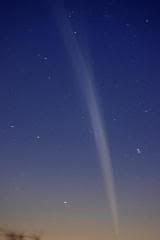
QUOTE
I went to The Briars (Mornington Peninsula AS HQ) down at Mt Martha yesterday morning 22Dec11, got there around 0340.
Greeting me were Rod Brackenridge and Greg Walton. Greg had setup 3 binocular chairs, an 8" SCT and 3 SLR cameras. I arrived prior to the comet rising so a very pleasant and comfortable time was had by all just generally admiring the sky, (which was beautiful and clear almost to the SE horizon)with 10 x 80's when at 0410 Greg said, "Someone's got a searchlight on over towards Hastings". He was right except for the fact that the beam was curved slightly northwards. I'd never heard of a curved searchlight beam and it wasn't moving about so it was then that we realised that it was the comet. It was easily visible, we didn't need binos. I stuck my hand out at arm's length and found that it just covered the comet so I guess the length was about 15-20 deg. We couldn't see a head, it may have been too low in the atmosphere. I had a look for comparison stars and took a punt on it being around mag 2 or 3. Very hard to work out with accuracy as the Sun was rising. The comet stayed visible even thru astronomical twilight.
Finally at 0444 we lost it.
Greg took lots of photos as his cameras were set to auto expose for around 10 secs each. He got a nice shot of the tail with a 120mm lens and when zoomed in clearly showed the split. It was a WOW moment.
Merry Xmas to all!
-- Geoff Dudley
Greeting me were Rod Brackenridge and Greg Walton. Greg had setup 3 binocular chairs, an 8" SCT and 3 SLR cameras. I arrived prior to the comet rising so a very pleasant and comfortable time was had by all just generally admiring the sky, (which was beautiful and clear almost to the SE horizon)with 10 x 80's when at 0410 Greg said, "Someone's got a searchlight on over towards Hastings". He was right except for the fact that the beam was curved slightly northwards. I'd never heard of a curved searchlight beam and it wasn't moving about so it was then that we realised that it was the comet. It was easily visible, we didn't need binos. I stuck my hand out at arm's length and found that it just covered the comet so I guess the length was about 15-20 deg. We couldn't see a head, it may have been too low in the atmosphere. I had a look for comparison stars and took a punt on it being around mag 2 or 3. Very hard to work out with accuracy as the Sun was rising. The comet stayed visible even thru astronomical twilight.
Finally at 0444 we lost it.
Greg took lots of photos as his cameras were set to auto expose for around 10 secs each. He got a nice shot of the tail with a 120mm lens and when zoomed in clearly showed the split. It was a WOW moment.
Merry Xmas to all!
-- Geoff Dudley
One of the photos mentioned above:

Now that Lovejoy is "officially" a Great Comet, I have decided to update the ranking of the Great Comets of the past several centuries that I had done here at the time of comet McNaught in 2007.
The point scale went like this:
No points in this category.
The last confirmed report I read gave a tail length of about 28 degrees, for 14 points. I also assume the minimum duration of visibility of one month, for one additional point.
While currently fading, the tail was considered bright earlier, for 10 points, and it will be circumpolar all night after New Years Day, for another 10 points. It also reached about magnitude -4 when rounding the sun, for 10 additional points. There were definitely two visible tails, a dust dail and an ion tail, for 10 points. While its tail is curved, it was not curved strongly enough to gain more points. This may change as the viewing geometry changes.
Using these numbers, comet Lovejoy currently garners 55 points.
The updated list:
1861 123 pts Tebbutt
2007 105 pts McNaught
1882 101 pts Great September Comet
1910 95 pts P/Halley
1976 90 pts West
1996 78 pts Hyakutake
1997 73 pts Hale-Bopp
1858 68 pts Donati
1965 64 pts Ikeya-Seki
1970 61 pts Bennett
1957 57 pts Arend-Roland
2011 55 pts Lovejoy
1910 54 pts Daylight Comet
1811 52 pts Great Comet
1927 51 pts Skjellerup-Maristany
1843 50 pts Great March Comet
1874 46 pts Coggia
1881 42 pts Great Comet
1807 37 pts Great Comet
1853 37 pts Klinkerfues
1835 35 pts P/Halley
1957 35 pts Mrkos
1860 31 pts Great Comet
1911 29 pts Beljawsky
1911 28 pts Brooks
1819 25 pts Tralles
1854 24 pts Great Comet
Here is the same list in reverse chronological order:
2011 55 pts Lovejoy
2007 105 pts McNaught
1997 73 pts Hale-Bopp
1996 78 pts Hyakutake
1976 90 pts West
1970 61 pts Bennett
1965 64 pts Ikeya-Seki
1957 57 pts Arend-Roland
1957 35 pts Mrkos
1927 51 pts Skjellerup-Maristany
1911 29 pts Beljawsky
1911 28 pts Brooks
1910 95 pts P/Halley
1910 54 pts Daylight Comet
1882 101 pts Great September Comet
1881 42 pts Great Comet
1874 46 pts Coggia
1861 123 pts Tebbutt
1860 31 pts Great Comet
1858 68 pts Donati
1854 24 pts Great Comet
1853 37 pts Klinkerfues
1843 50 pts Great March Comet
1835 35 pts P/Halley
1819 25 pts Tralles
1811 52 pts Great Comet
1807 37 pts Great Comet
The point scale went like this:
QUOTE
MAGNITUDE: 10 points for every degree of magnitude brighter than +3 (dark-sky; daytime magnitude gets counted separately)
No points in this category.
QUOTE
TAIL: 1 point for every two degrees of length of naked-eye visible tail in dark sky
DURATION VISIBLE: 1 point for every month naked-eye visible in dark sky
DURATION VISIBLE: 1 point for every month naked-eye visible in dark sky
The last confirmed report I read gave a tail length of about 28 degrees, for 14 points. I also assume the minimum duration of visibility of one month, for one additional point.
QUOTE
BONUS POINTS:
2 visible tails = 10 points
5 visible tails (West 1976) = 20 points
15 degree long anti-tail (Arend-Roland 1957) = 10 points
curved tail (Donati 1858) = 5 points
'bright' tail (Daylight 1910) = 10 points
'brilliant' tail (Ikeya-Seki 1965, Great September 1882) = 20 points
circumpolar all night (Hyakutake 1996, Tebbutt 1861) = 10 points
Mag. -3 in daylight (West 1976) or Mag. -5 in daylight (Daylight 1910) = 10 points
Mag. -8 in daylight (Great March 1843) = 15 points
Mag. -15 in daylight (Ikeya-Seki 1965) or Mag. -17 in daylight (Great September 1882) = 30 points
2 visible tails = 10 points
5 visible tails (West 1976) = 20 points
15 degree long anti-tail (Arend-Roland 1957) = 10 points
curved tail (Donati 1858) = 5 points
'bright' tail (Daylight 1910) = 10 points
'brilliant' tail (Ikeya-Seki 1965, Great September 1882) = 20 points
circumpolar all night (Hyakutake 1996, Tebbutt 1861) = 10 points
Mag. -3 in daylight (West 1976) or Mag. -5 in daylight (Daylight 1910) = 10 points
Mag. -8 in daylight (Great March 1843) = 15 points
Mag. -15 in daylight (Ikeya-Seki 1965) or Mag. -17 in daylight (Great September 1882) = 30 points
While currently fading, the tail was considered bright earlier, for 10 points, and it will be circumpolar all night after New Years Day, for another 10 points. It also reached about magnitude -4 when rounding the sun, for 10 additional points. There were definitely two visible tails, a dust dail and an ion tail, for 10 points. While its tail is curved, it was not curved strongly enough to gain more points. This may change as the viewing geometry changes.
Using these numbers, comet Lovejoy currently garners 55 points.
The updated list:
1861 123 pts Tebbutt
2007 105 pts McNaught
1882 101 pts Great September Comet
1910 95 pts P/Halley
1976 90 pts West
1996 78 pts Hyakutake
1997 73 pts Hale-Bopp
1858 68 pts Donati
1965 64 pts Ikeya-Seki
1970 61 pts Bennett
1957 57 pts Arend-Roland
2011 55 pts Lovejoy
1910 54 pts Daylight Comet
1811 52 pts Great Comet
1927 51 pts Skjellerup-Maristany
1843 50 pts Great March Comet
1874 46 pts Coggia
1881 42 pts Great Comet
1807 37 pts Great Comet
1853 37 pts Klinkerfues
1835 35 pts P/Halley
1957 35 pts Mrkos
1860 31 pts Great Comet
1911 29 pts Beljawsky
1911 28 pts Brooks
1819 25 pts Tralles
1854 24 pts Great Comet
Here is the same list in reverse chronological order:
2011 55 pts Lovejoy
2007 105 pts McNaught
1997 73 pts Hale-Bopp
1996 78 pts Hyakutake
1976 90 pts West
1970 61 pts Bennett
1965 64 pts Ikeya-Seki
1957 57 pts Arend-Roland
1957 35 pts Mrkos
1927 51 pts Skjellerup-Maristany
1911 29 pts Beljawsky
1911 28 pts Brooks
1910 95 pts P/Halley
1910 54 pts Daylight Comet
1882 101 pts Great September Comet
1881 42 pts Great Comet
1874 46 pts Coggia
1861 123 pts Tebbutt
1860 31 pts Great Comet
1858 68 pts Donati
1854 24 pts Great Comet
1853 37 pts Klinkerfues
1843 50 pts Great March Comet
1835 35 pts P/Halley
1819 25 pts Tralles
1811 52 pts Great Comet
1807 37 pts Great Comet
As expected, comet Lovejoy is growing more prominent as the New Moon approaches, and as the comet itself gets nearer. From Vello Tabur in comet-ml post #19044:
QUOTE
Finally, I didn't have to drive too far this morning - only 30 mins out of Canberra to an old comet hunting location. My son and I arrived at 3 am and were immediately treated to a glorious sight upon stepping out of the car, with 2/3 of the tail already above the horizon. The comet seems brighter again, now that it is visible in a dark sky without moonlight interference. The brightest part (about 1/3 of the way along the tail from the head) easily outshines the LMC.
Got a few nice snaps too but I've only had time to put up this one:

Got a few nice snaps too but I've only had time to put up this one:

The tail is getting bigger! From Rob Kaufman in comet-ml post #19045:
QUOTE
From Robert McNaught, comet-ml post #19047:
He also linked to several outstanding photos that he had taken:

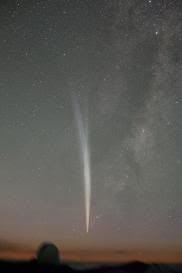
QUOTE
Despite a huge downpour of rain around midday, the humidity after midnight was sufficiently low that once the cloud passed, there was no fog or significant orographic cloud.
My initial impression as the comet was rising was that it was less bright than on Dec 21, leaving me a little disappointed. However once the full extent of the comet was visible, it continues to be awesome! Unlike Vello, I do suspect an overall fading, although it did appear to be a bit higher surface brightness than the LMC.
A scan with 10x50B really didn't show much structure, although the gas tail was more evident in the binoculars than to the naked eye. In 20x120B there is no sign of any condensation. Instead a little "spine" is evident (more on this later). The overall tail length from the photos is 21.7 deg for the dust tail and much the same for the dust. Averted imagination could make it longer, but I think lines of stars are being misleading.
My initial impression as the comet was rising was that it was less bright than on Dec 21, leaving me a little disappointed. However once the full extent of the comet was visible, it continues to be awesome! Unlike Vello, I do suspect an overall fading, although it did appear to be a bit higher surface brightness than the LMC.
A scan with 10x50B really didn't show much structure, although the gas tail was more evident in the binoculars than to the naked eye. In 20x120B there is no sign of any condensation. Instead a little "spine" is evident (more on this later). The overall tail length from the photos is 21.7 deg for the dust tail and much the same for the dust. Averted imagination could make it longer, but I think lines of stars are being misleading.
QUOTE
So just what is happening at the heart of the comet? My interpretation, which I fully admit is from a position of ignorance, would be that there is an intact nucleus. This is based on the "spine" coming to a sharp point close to the the parabolic hood. If it were dissipating I would have expected the spine to be more diffused and for the parabolic hood to diffuse with it. There will be plenty of folks here that interpret the situation more reliably than me, but it certainly doesn't seem to be a Shetland comet ;-) (that's a Scottish joke).
Until tomorrow night.
Cheers, Rob
Until tomorrow night.
Cheers, Rob
He also linked to several outstanding photos that he had taken:


More confirmation of today's observations, by Chris W in comet-ml post #19050:
QUOTE
Hi all,
This morning i had to travel to a roadside spot between Nemingha and Loomberah (near Tamworth NSW) to view the comet. I arrived there at 3:50am AEDST only to find over half the comet has already risen!
At 4:20am AEDST i observed the comet's tail to be 22 degrees in length, the tail tip about 2 to 3 degrees in width and comparable in brightness to the Small Magellanic Cloud, the mid section between the head and "tail-split" about half a degree in width and comparable in brightness of the bar in the Large Magellanic Cloud. The comet head had no central condensation visible through 7x50 B's. The overall brightness of the comet appeared fainter than my previous observation 2 mornings earlier, the tail split was not as noticeable and the ion tail was hardly discernable.
This morning i had to travel to a roadside spot between Nemingha and Loomberah (near Tamworth NSW) to view the comet. I arrived there at 3:50am AEDST only to find over half the comet has already risen!
At 4:20am AEDST i observed the comet's tail to be 22 degrees in length, the tail tip about 2 to 3 degrees in width and comparable in brightness to the Small Magellanic Cloud, the mid section between the head and "tail-split" about half a degree in width and comparable in brightness of the bar in the Large Magellanic Cloud. The comet head had no central condensation visible through 7x50 B's. The overall brightness of the comet appeared fainter than my previous observation 2 mornings earlier, the tail split was not as noticeable and the ion tail was hardly discernable.
A response by Vello Tabur in comet-ml post #19055 to Rob McNaught's post #19047, two posts above this one:
QUOTE
Hi Rob,
It's quite possible that the comet has faded somewhat. My comments were relative to a reference point of two nights ago (Dec 21.7 UT), when there was still moonlight interference. I didn't see it the following night due to fatigue (I needed some sleep after racking up nearly 1000 km in the last few days). The view last night (Dec 23.7) finally had the comet reasonably high in a dark sky. Relative to 2 nights before, it was significantly easier to see with the naked eye and far more impressive. To my eye, it had transformed from a ghostly spectre to something of real substance. Having said that, I agree that the ion tail was less obvious and less structure was visible in the tail through binoculars. Overall -- still awesome!
Cheers,
Vello
It's quite possible that the comet has faded somewhat. My comments were relative to a reference point of two nights ago (Dec 21.7 UT), when there was still moonlight interference. I didn't see it the following night due to fatigue (I needed some sleep after racking up nearly 1000 km in the last few days). The view last night (Dec 23.7) finally had the comet reasonably high in a dark sky. Relative to 2 nights before, it was significantly easier to see with the naked eye and far more impressive. To my eye, it had transformed from a ghostly spectre to something of real substance. Having said that, I agree that the ion tail was less obvious and less structure was visible in the tail through binoculars. Overall -- still awesome!
Cheers,
Vello
Mongo, I just want to say thanks for these summaries -- it's great to have a single, concise source for the latest comet visibility news! Though it's making me very jealous of our southern hemisphere friends.
Mongo, I just want to say thanks for these summaries -- it's great to have a single, concise source for the latest comet visibility news! Though it's making me very jealous of our southern hemisphere friends.
Ditto. I've been thinking about driving to Argentina. It's only 6451 miles.
That would be rather tricky, considering the Darien Gap...
W O W ! ! !
Yes, I think that Lovejoy has done quite well for a comet that was not supposed to survive perihelion.
From comet-ml post #19078 by David Seargent:
QUOTE
I thought that the tail was somewhat less intense but longer than on the previous 2 mornings and the head (which was very indistinct and essentially just a lower terminus of the tail) about magnitude 4.8. By the way, the 15 degrees I gave as the tail length for Dec. 21 should read 21 degrees. I left out a term in the formula used for calculating angular distances on the sky (OK, math was never my strong point. If it had been, I probably would have studied Physics instead of Philosophy and become a professional astronomer!). In any case, this mornings tail length was measured as 28 degrees.
QUOTE
The length, shape and general morphology of the tail looked very similar to that of Ikeya-Seki when observed the same number of days after perihelion. Yet, I-S was definitely more intense; I would guess from memory about 2 magnitudes brighter. Also, the terminus of the tail seemed to end more suddenly than that of Lovejoy (the last 5 degrees or so of W3's tail grew very faint and difficult with the naked eye and could not be traced in the telescope). But the biggest difference was the head. At this point in its orbit, the head of the earlier comet was also about 2 magnitudes brighter and appeared in the 20x65 binoculars that I was then using as a very distinct, almost disk-like object; rather like a very bright and compact planetary nebula.
From comet-ml post #19088 by Robert McNaught:
QUOTE
On Sun, 25 Dec 2011, [iso-8859-2] Jakub Černý wrote:
> Actually I do not think that nucleus has dissipated. Activity just fade
> quickly, but apparently there is still something huge producing much more
> material into tail and coma, unlikely swarm of debries.
Thanks Jakub,
I tend to agree that there is an "invisible" mass responsible for the hood and spine. The tail is showing no signs of becoming a ghost. I've put up a processed Uppsala image from last night (Dec 24.7UT).
http://msowww.anu.edu.au/~rmn/C2011W3.htm
It continues to show a well defined parabolic hood and the spine narrowing basically to an "empty" point pretty much on the edge of the parabola. Trying to image it now, but there is cloud and I can't get a focus sequence.
My astrometry of the tip-of-the-spine will perhaps tell one way or another whether this is a substantial mass or displaying significant short-term non-gravitional effects. Give it a week and we should a good handle on the dynamics.
The tail continues to fade (Dec 25.7UT) and is very significantly less bright than on Dec 21. There was quite a similarity to Hyakutake tonight, partly due to the tail being so long, narrow and "ghostly". There is no real comparison though, as there is no coma and condensation, which were both prominent in Hyakutake. On Dec 21 though, the tail surface brightness was sufficient to put it in the "awesome" category for me. Very much on par with Hyakutake, Hale-Bopp and Bennett. Tonight it was much more Halleyesque. I'll reply to the great comet listing thread in a day or so as I've been keeping such a list (and noting other folks lists) for a couple of decades.
> Actually I do not think that nucleus has dissipated. Activity just fade
> quickly, but apparently there is still something huge producing much more
> material into tail and coma, unlikely swarm of debries.
Thanks Jakub,
I tend to agree that there is an "invisible" mass responsible for the hood and spine. The tail is showing no signs of becoming a ghost. I've put up a processed Uppsala image from last night (Dec 24.7UT).
http://msowww.anu.edu.au/~rmn/C2011W3.htm
It continues to show a well defined parabolic hood and the spine narrowing basically to an "empty" point pretty much on the edge of the parabola. Trying to image it now, but there is cloud and I can't get a focus sequence.
My astrometry of the tip-of-the-spine will perhaps tell one way or another whether this is a substantial mass or displaying significant short-term non-gravitional effects. Give it a week and we should a good handle on the dynamics.
The tail continues to fade (Dec 25.7UT) and is very significantly less bright than on Dec 21. There was quite a similarity to Hyakutake tonight, partly due to the tail being so long, narrow and "ghostly". There is no real comparison though, as there is no coma and condensation, which were both prominent in Hyakutake. On Dec 21 though, the tail surface brightness was sufficient to put it in the "awesome" category for me. Very much on par with Hyakutake, Hale-Bopp and Bennett. Tonight it was much more Halleyesque. I'll reply to the great comet listing thread in a day or so as I've been keeping such a list (and noting other folks lists) for a couple of decades.
Comet-ml post #19096 by Rob Kaufman:
QUOTE
Here's a rough composite showing the growth of Lovejoy over the last 4 days, using some images kindly lent to me as I've only had one fine morning to observe it since it hit dark skies again. The various images were resized to the same scale. Don't place too much credence in the actual degree length stated as there are lots of variables that determine how much will be showing in any particular image. For this morning, the 30-degree tail length is based on several photographs that appear to show very faint extensions out to that length.

Anyway, the massive expansion is pretty clear. Hoping to get another great view of this 'megacomet' in the morning.
Cheers -
Rob Kaufman
Bright, Vic, Australia

Anyway, the massive expansion is pretty clear. Hoping to get another great view of this 'megacomet' in the morning.
Cheers -
Rob Kaufman
Bright, Vic, Australia
Comet-ml post #19100 bt Dave Herald, regarding the visual brightness of comet Lovejoy:
QUOTE
IMHO, most of the images that have been posted over the last few days reflects the true visual appearance. Specifically, in dark skies you can see the tail to the same extent as is shown in the images.
The main issue is how you might represent the brightness of the comet's tail. I think the best way to describe this is that the comet is currently close to one of the brighter parts of the Milky Way, and compared to the milky way at the same altitude, the surface brightness of the majority of the tail is somewhat brighter than the brighter parts of the Milky Way.
Dave Herald
Murrumbateman, Australia
The main issue is how you might represent the brightness of the comet's tail. I think the best way to describe this is that the comet is currently close to one of the brighter parts of the Milky Way, and compared to the milky way at the same altitude, the surface brightness of the majority of the tail is somewhat brighter than the brighter parts of the Milky Way.
Dave Herald
Murrumbateman, Australia
Comet-ml post #19101 by Rob Kaufman:
QUOTE
Hi Frans. I can only speak for the 23rd (24th here), but the visual view was very much the same as the photograph shown in the composite. In darker skies the tail was quite bright and prominent. I made out 20 degrees of tail visually, but didn't see the head or last couple of degrees of tail rise because daylight washed it out. The ion tail on the 23rd was quite prominent visually and the extent of faint end of the tail visible matched the photograph quite well.
Cheers -
Rob
Cheers -
Rob
From comet-ml post #19115 by Jim Gifford:
QUOTE
As the comet's tail rose tonight it was at first hard to pick against the Milky Way background. The higher it rose the easier it became because of the straight edges of the tail. It has faded considerably since I observed it last on the 24th December but is now much longer at 28 degrees. It became striking to observe only when its full length was above the horizon and it stood vertically below the Southern Cross. All the intensity has gone out of the head and tail.
From comet-ml post #19117 by Rob Kaufman:
He also posted this image:
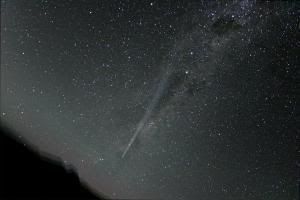
QUOTE
Nice report Jim. I too observed it this morning, starting earlier at 1:30am (UT+11) with a fair bit of the fainter tail showing. I had also observed it on the 24th (23rd UT) and this morning it was considerably fainter, and longer. I could imagine that now, combined with interference from the Milky Way, it might be difficult to see in light-polluted skies. Nonetheless, I found it quite impressive still from my very dark sky site. Gone are the 'ribbon' structures and the ion tail evident on the 24th, and the tail (naked-eye, binoculars & photographic) shows no structure. The tail appeared fairly bright for the first 10-deg or so, but naked eye the exact position of the head was difficult to make out as the tail narrowed down to nothing. Not so with binoculars or photographically.
As the tail fanned out the surface brightness diminished although it was quite clear as far as the top Pointer, a distance of 28-deg. Naked-eye I could make it out faintly to halfway between the top Pointer & the Southern Cross, about 33-deg. Nothing could be seen there with binoculars - in fact even the section adjacent to the Pointers was difficult to make out with binoculars. Photography seems to show some faint hints of dust extending to adjacent to the Cross (perhaps 38-deg) but I need to check some reference images to see if it's just fortuitously aligned bright patches.
Was it John Bortle who predicted the comet would expand & dim to became a huge 'ghost'? Because that's the impression I got. The comet would still be a striking sight away from the Milky Way, but even in amongst it I found the sight of this great ghost transfixing, a true wonder!
As the tail fanned out the surface brightness diminished although it was quite clear as far as the top Pointer, a distance of 28-deg. Naked-eye I could make it out faintly to halfway between the top Pointer & the Southern Cross, about 33-deg. Nothing could be seen there with binoculars - in fact even the section adjacent to the Pointers was difficult to make out with binoculars. Photography seems to show some faint hints of dust extending to adjacent to the Cross (perhaps 38-deg) but I need to check some reference images to see if it's just fortuitously aligned bright patches.
Was it John Bortle who predicted the comet would expand & dim to became a huge 'ghost'? Because that's the impression I got. The comet would still be a striking sight away from the Milky Way, but even in amongst it I found the sight of this great ghost transfixing, a true wonder!
He also posted this image:

Comet-ml post #19119 by John Bortle:
QUOTE
--- In comets-ml@yahoogroups.com, "Rob" <Rob.Kau@...> wrote:
>
> Was it John Bortle who predicted the comet would expand & dim to became a huge 'ghost'? Because that's the impression I got. The comet would still be a striking sight away from the Milky Way, but even in amongst it I found the sight of this great ghost transfixing, a true wonder!
>
> Rob Kaufman
> Bright, Vic, Australia
>
At this time I would hasten to point out that based on descriptions of the Post-T evolution so far, 2011 W3 is almost precisely mimicing the physical appearance of the Great Southern Comet of 1880 during it apparition.
If this continues I would predict that by about next weekend 2011 W3's tail will have assumed essentially the same low level of brightness over virtually its entire length. As it fades toward obscurity, it will attain a maximum length between 50 and 60 degrees as seen from the darkest observing sites, but be exceedingly faint and ghostly in its appearance. At the same time the head will fade way completely, the sunward end of the tail simply fading to nothingness against the sky.
Incidentally, my main computer is down and I'm working from a tiny and frustrating laptop, so please forgive typing errors. I'm also unsure just how much I will be able to participate on the forum this week until my big machine returns.
J.Bortle
>
> Was it John Bortle who predicted the comet would expand & dim to became a huge 'ghost'? Because that's the impression I got. The comet would still be a striking sight away from the Milky Way, but even in amongst it I found the sight of this great ghost transfixing, a true wonder!
>
> Rob Kaufman
> Bright, Vic, Australia
>
At this time I would hasten to point out that based on descriptions of the Post-T evolution so far, 2011 W3 is almost precisely mimicing the physical appearance of the Great Southern Comet of 1880 during it apparition.
If this continues I would predict that by about next weekend 2011 W3's tail will have assumed essentially the same low level of brightness over virtually its entire length. As it fades toward obscurity, it will attain a maximum length between 50 and 60 degrees as seen from the darkest observing sites, but be exceedingly faint and ghostly in its appearance. At the same time the head will fade way completely, the sunward end of the tail simply fading to nothingness against the sky.
Incidentally, my main computer is down and I'm working from a tiny and frustrating laptop, so please forgive typing errors. I'm also unsure just how much I will be able to participate on the forum this week until my big machine returns.
J.Bortle
Comet-ml post #19122 by David Seargent
QUOTE
Hi all,
This morning (Dec. 26, 1600-1650 UT) about 37 degrees of tail could be seen from Cowra, reaching up to the outer edges of the Southern Cross. Interestingly, this was the first time that something that could be called a "head" was discernible in the 25x100 BT. At the end of the tail, there was a small (approx 4 arcmin) very diffuse, transparent nebulous blob slightly brighter than the adjoining tail (m = 5.3). The distinction between "head' and "tail end" was more apparent using averted vision, but it was truly there! The two earlier sungrazers that I saw developed in a similar way, albeit much later after perihelion. Ikeya-Seki about 7 weeks after perihelion and White-Ortiz-Bolelli about 3. I would guess that the early diffusing of 2011 W3 probably signifies a small comet shutting down whilst still closer to the Sun rather than one that is disintegrating. On the other hand, the tail (although much fainter) is still very distinct and remains impressive in a dark sky. The length is truly amazing ... lengthening even while it fades!
Cheers,
David
This morning (Dec. 26, 1600-1650 UT) about 37 degrees of tail could be seen from Cowra, reaching up to the outer edges of the Southern Cross. Interestingly, this was the first time that something that could be called a "head" was discernible in the 25x100 BT. At the end of the tail, there was a small (approx 4 arcmin) very diffuse, transparent nebulous blob slightly brighter than the adjoining tail (m = 5.3). The distinction between "head' and "tail end" was more apparent using averted vision, but it was truly there! The two earlier sungrazers that I saw developed in a similar way, albeit much later after perihelion. Ikeya-Seki about 7 weeks after perihelion and White-Ortiz-Bolelli about 3. I would guess that the early diffusing of 2011 W3 probably signifies a small comet shutting down whilst still closer to the Sun rather than one that is disintegrating. On the other hand, the tail (although much fainter) is still very distinct and remains impressive in a dark sky. The length is truly amazing ... lengthening even while it fades!
Cheers,
David
Comet-ml post #19122 by Vello Tabur
QUOTE
Hi,
I concur with the descriptions provided by others this morning. Although the comet has faded significantly, it still remains an easy naked eye object. From a dark-sky site near Boorowa, NSW, the tail was fainter than the nearby Milky Way and is now only slightly brighter than the SMC. There is no sign of the ion tail and the dust tail appears slightly narrower than on my last observation 2 days earlier. Visually, I could only trace the tail to the same altitude as midway between alpha/beta Centuri but, the wide-field image below hints at a continuation toward Crux, as noted by David S.

Vello
I concur with the descriptions provided by others this morning. Although the comet has faded significantly, it still remains an easy naked eye object. From a dark-sky site near Boorowa, NSW, the tail was fainter than the nearby Milky Way and is now only slightly brighter than the SMC. There is no sign of the ion tail and the dust tail appears slightly narrower than on my last observation 2 days earlier. Visually, I could only trace the tail to the same altitude as midway between alpha/beta Centuri but, the wide-field image below hints at a continuation toward Crux, as noted by David S.

Vello
From comet-ml post #19128 by Michael Mattiazzo:
QUOTE
The tail is noticeably fainter than 2 mornings ago, however it is still growing as the comet approaches Earth. Closest on Jan 8 at 0.5AU. The tail is seen visually for 30 degrees, extending to near Beta Centauri. This photo shows a fainter extension out to 38 degrees! The first 10 degrees of tail is still relatively bright, comparable to the norma starcloud.


A spectacular image hosted on Gary Kronk's Cometography website. Photo taken by Gordon Garradd on December 22:
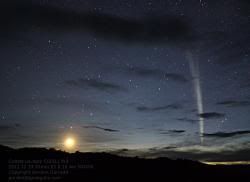

Comet-ml post #19131 by Andrew Pearce:
QUOTE
Hi all
I finally observed this wonderful comet from a very dark sky site in northern Victoria (Lockington) Australia. The tail now extends almost to the Coalsack nebula. I measured it as 30.0 degrees on Dec 28.74UT. What is most striking about it is it's extreme straightness. For all the long tailed comets I've observed there always appears to be some degree of curvature but not so with C/2011W3. The surface brightness is fainter now and would be a struggle to see much in a light polluted area but it is very impressive from my current dark sky site. To the naked eye, the head of the comet is virtually non existent and I'm not sure there's a lot of value in a coma total magnitude estimate.
Regards
Andrew Pearce
I finally observed this wonderful comet from a very dark sky site in northern Victoria (Lockington) Australia. The tail now extends almost to the Coalsack nebula. I measured it as 30.0 degrees on Dec 28.74UT. What is most striking about it is it's extreme straightness. For all the long tailed comets I've observed there always appears to be some degree of curvature but not so with C/2011W3. The surface brightness is fainter now and would be a struggle to see much in a light polluted area but it is very impressive from my current dark sky site. To the naked eye, the head of the comet is virtually non existent and I'm not sure there's a lot of value in a coma total magnitude estimate.
Regards
Andrew Pearce
Comet-ml post #19142 by Andrew Pearce
QUOTE
Hi All
The tail surface brightness is decreasing every day and as Rob mentioned, whilst it is visible with direct vision it is not easy. With averted vision however it is quite distinct. On Dec 29.73UT I measured the tail length as 32.0 degrees. It now extends almost to Alpha Crucis and can be faintly seen crossing the southern edge of the Coalsack nebula. It would be difficult to observe a longer tail than that visually as the line of the tail past Alpha Crucis extends into an area of the Milky Way which is very bright and the tail would be difficult to discern in this area and that will probably be the case over the next few mornings. The last 10 degrees or so of the tail is quite vague and ill defined in comparison to the first 20 degrees which is still quite narrow and very straight.
I'm leaving the dark country skies today so this will be my last observation but it's been a fascinating last week!
Regards
Andrew Pearce
The tail surface brightness is decreasing every day and as Rob mentioned, whilst it is visible with direct vision it is not easy. With averted vision however it is quite distinct. On Dec 29.73UT I measured the tail length as 32.0 degrees. It now extends almost to Alpha Crucis and can be faintly seen crossing the southern edge of the Coalsack nebula. It would be difficult to observe a longer tail than that visually as the line of the tail past Alpha Crucis extends into an area of the Milky Way which is very bright and the tail would be difficult to discern in this area and that will probably be the case over the next few mornings. The last 10 degrees or so of the tail is quite vague and ill defined in comparison to the first 20 degrees which is still quite narrow and very straight.
I'm leaving the dark country skies today so this will be my last observation but it's been a fascinating last week!
Regards
Andrew Pearce
Comet-ml post #19150 by Chris:
QUOTE
Hi all,
I observed this morning from 20kms East of Walcha, i also tried around 10:30pm on the evening of 30th Dec but moonlight washed out the tail in the background sky.
The tail was dimmer than SMC and slightly fainter than the Milky Way area just below the Pointers, i traced the tail to 22 degrees with the naked eye, which was just past Beta Cen, the eastern side of the tail end seemed to curve slightly to the East, the Western side appeared realtively straight.
There was a gap between the Milky way and the tail mid section which helped locate it with naked eye.
With 7x50 B's the head of the comet was 15' in dia, the width of the tail in the mid section was around 2 degrees, and fanned out to around 3.5 to 4 degrees at the end.
I did get a mag estimate but need to get to my program which is at work.
Cheers,
Chris W
I observed this morning from 20kms East of Walcha, i also tried around 10:30pm on the evening of 30th Dec but moonlight washed out the tail in the background sky.
The tail was dimmer than SMC and slightly fainter than the Milky Way area just below the Pointers, i traced the tail to 22 degrees with the naked eye, which was just past Beta Cen, the eastern side of the tail end seemed to curve slightly to the East, the Western side appeared realtively straight.
There was a gap between the Milky way and the tail mid section which helped locate it with naked eye.
With 7x50 B's the head of the comet was 15' in dia, the width of the tail in the mid section was around 2 degrees, and fanned out to around 3.5 to 4 degrees at the end.
I did get a mag estimate but need to get to my program which is at work.
Cheers,
Chris W
From comet-ml post #19154 by Michael Mattiazzo
QUOTE
The visual tail length with the unaided eye has reduced to 17 degrees, traceable to Alpha Circinus and photographically about 25 degrees. The bright milky way is interfering with the view.
The tail is continuing to fade with each passing morning and is now of similar surface brightness to the SMC.
Thus probably not observable from light polluted city skies.
Whether the reduced tail length is real or not, we will need to wait a few more days for the comet to move away from the milky way.
The tail is continuing to fade with each passing morning and is now of similar surface brightness to the SMC.
Thus probably not observable from light polluted city skies.
Whether the reduced tail length is real or not, we will need to wait a few more days for the comet to move away from the milky way.
Comet-ml post #19169 and #19174 by David Seargent
QUOTE
Hi All,
The tail has cleared the brightest part of the MW and this morning (Dec. 31. 1600 UT) I'm sure that I could trace it with averted vision into Carina; a length of (wait for it!) 45 degrees! The sky was very clear with a limiting naked-eye magnitude of around 6.5 or better.
Cheers,
David
The tail has cleared the brightest part of the MW and this morning (Dec. 31. 1600 UT) I'm sure that I could trace it with averted vision into Carina; a length of (wait for it!) 45 degrees! The sky was very clear with a limiting naked-eye magnitude of around 6.5 or better.
Cheers,
David
QUOTE
Hi Rob and all,
Yes, I did put down a couple of wrong numbers (lack of sleep I guess). Still, it does not make a very great difference. The revised length comes out at 39 degrees ... and this time I checked the numbers! The end appeared to be near Theta Carinae, visible with averted vision only in "flashes". Perhaps it was averted imagination, but I think it was real.
Cheers,
David
Yes, I did put down a couple of wrong numbers (lack of sleep I guess). Still, it does not make a very great difference. The revised length comes out at 39 degrees ... and this time I checked the numbers! The end appeared to be near Theta Carinae, visible with averted vision only in "flashes". Perhaps it was averted imagination, but I think it was real.
Cheers,
David
Comet-ml post #19176 by John Bortle:
QUOTE
By physical necessity and as I've pointed out previously, the dust tail of 2011 W3 SHOULD be continuing to lengthen...at least until the surface brightness of the outermost portions drop completely below the detection limits of the method being employed. For the unaided eye I'm afraid that this will occur fairly soon. However, for appropriately long exposed, highly processed, fairly small-scale images this interval should be considerably extended.
If astro-imagers familiar with the sorts of image processing done to bring out the absolute threshold details in such objects as galaxies apply their techniques to appropriate images of the comet I see no reason for the ultimate length of the tail not turning out to be something in the order of 50-60 degrees by mid January. I know that years ago when I dabbled in this area I could bring out details far beyond what I ever imagined were in the original images (although the pictures no longer were very pretty to look at!)
J.Bortle
If astro-imagers familiar with the sorts of image processing done to bring out the absolute threshold details in such objects as galaxies apply their techniques to appropriate images of the comet I see no reason for the ultimate length of the tail not turning out to be something in the order of 50-60 degrees by mid January. I know that years ago when I dabbled in this area I could bring out details far beyond what I ever imagined were in the original images (although the pictures no longer were very pretty to look at!)
J.Bortle
Just heard from my stepdaughter, who returned today from a holiday hiking vacation in southern Chile. Although she's not an astronomy buff, she said that the tail very much resembled a searchlight beam a few days ago so it must have been quite spectacular. One of her fellow travelers apparently acquired a great shot, so hopefully I'll get a copy & be able to post it in a few days.
This is a "lo-fi" version of our main content. To view the full version with more information, formatting and images, please click here.

